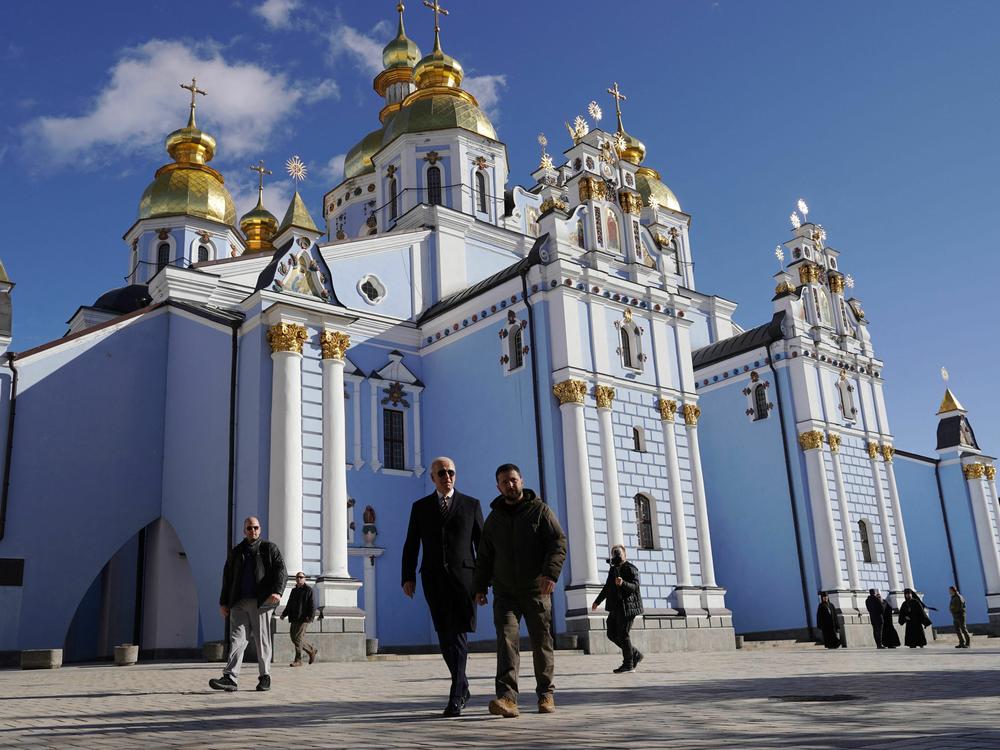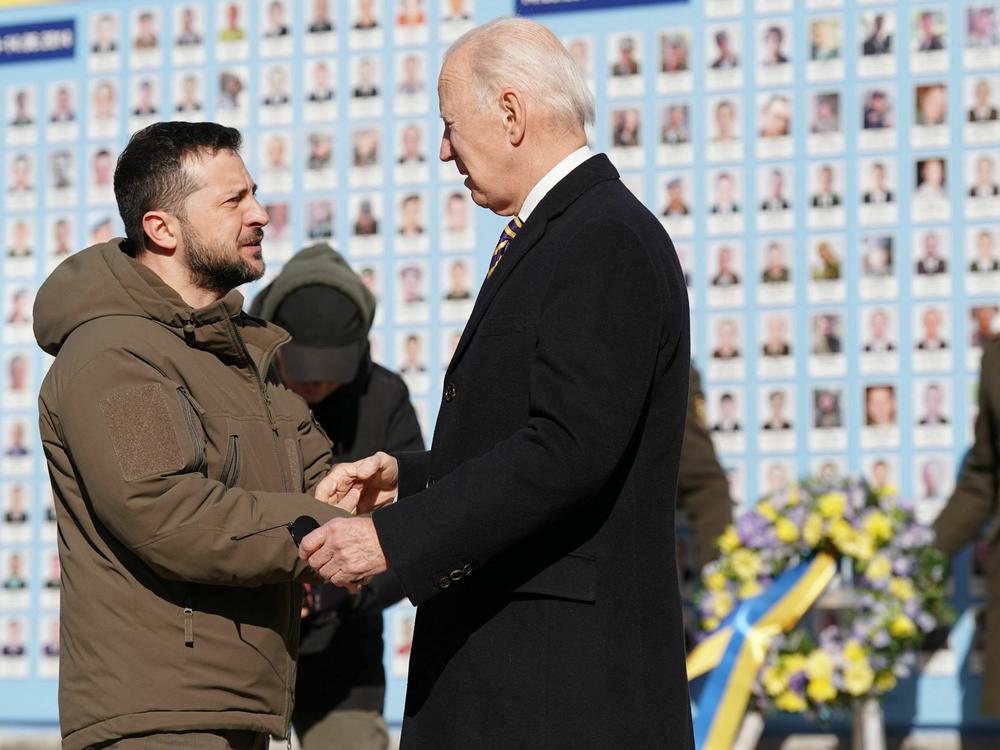Section Branding
Header Content
Biden visits Kyiv to show solidarity, says 'One year later, Ukraine still stands'
Primary Content
Updated February 20, 2023 at 5:27 PM ET
President Biden made an unannounced visit to Kyiv on Monday, an audacious and somewhat risky trip aimed at expressing solidarity with Ukrainians as Russia's invasion of their country heads into a second year.
Biden met with Ukrainian President Volodymyr Zelenskyy and announced a half a billion dollars of additional assistance to Ukraine — and said there would be new sanctions on Russia — with details to be released in the coming days.
"One year later, Kyiv stands. And Ukraine stands. Democracy stands," Biden said.
National security adviser Jake Sullivan, who traveled with Biden to Kyiv, said that the White House notified the Russians of the trip "some hours" ahead of his departure for "deconfliction purposes." On a call with reporters, Sullivan would not go into details about how the Russians responded or the nature of the U.S. message.
Biden's visit comes as Russian forces make a new push to take control of Ukraine's eastern Donbas region, which Russia illegally annexed last September.
Biden returned to Poland Monday evening. He is scheduled to meet with Polish President Andrzej Duda and give remarks in Warsaw on Tuesday.
How Biden's trip came together
Biden had been slated to travel to Warsaw this week to mark the anniversary of the war and to hold a series of meetings with central European allies. Instead, he secretly left Washington early on Sunday morning.
Only three White House officials, as well one reporter and one photographer, traveled with Biden. A small group of reporters already inside Ukraine — including NPR's Joanna Kakissis — joined Biden after his arrival at 8 a.m. local time.
Details of how he got to Ukraine were not immediately available due to security concerns, but once the president arrived back in Poland, the print reporter, who was present for Biden's journey from Washington, was able to share more about how the trip came together.
Biden left Washington in the middle of the night Sunday from Andrews Air Force Base. Air Force One sat in darkness with the shades drawn and away from the tarmac, where it is typically parked for presidential travel. The plane left at 4:15 a.m. ET on Sunday, and made one stop at Ramstein Air Base in Germany to refuel, before arriving at Rzeszów-Jasionka Airport in Poland at 7:57 p.m. local time on Sunday.
After deplaning, the group drove for roughly one hour in the president's motorcade, which did not use sirens as it typically does, and arrived at Przemyśl Główny train station in western Poland at approximately 9:15 p.m.
"It was relatively quiet at this time of night with a handful of people milling about outside the station and the stalls seemingly all closed," according to the print reporter traveling with Biden.
Biden boarded the train, which began moving toward Kyiv at 9:37 p.m. local time. Most of the train was occupied by a heavy security presence, and there was no interaction between the journalists present, the White House officials or the president during the 10 hour journey to Kyiv.
By roughly 8:00 a.m. local time, Biden arrived at the train station in Kyiv and was greeted by the U.S. Ambassador to Ukraine Bridget Brink.
Biden's first words upon arriving in the city were, "It's good to be back in Kyiv."
Sullivan told reporters that Biden's trip to Kyiv was "historic" and "unprecedented" for a sitting president given that the U.S. does not have a military presence on the ground there and only a limited embassy presence. While the trip was risky, Sullivan said Biden was confident that his security team was able to bring the risk to a "manageable level."
The plan for Biden's visit has been in the works for months between the White House and a limited number of people from the Pentagon, the Secret Service and the intelligence community.
Air sirens were going off during Biden's visit
Kyiv has been the target of Russian missile and drone strikes, including as recently as Feb. 10.
Biden met with Zelenskyy at Mariinsky Palace. Then, the two leaders walked together outside St. Michael's cathedral in central Kyiv. Air raid sirens were heard across the city as they left the church.
Zelenskyy called it "a huge moment for Ukraine" and "a historical moment for our country."
Zelenskyy called it "a huge moment for Ukraine" and "a historical moment for our country."
"I thought it was critical that there not be any doubt, none whatsoever, about U.S. support for Ukraine in the war," Biden said, emphasizing bipartisan support in Congress for Ukraine.
Sullivan said Biden was excited about that trip and that during the flight was focused on making the most of his limited time on the ground.
Sullivan said the trip was "filled with real anticipation that this was an important moment, and that the president was rising to the moment and felt he had an important mission to undertake and he wanted to do it."
Biden has marshalled international support for Ukraine, sending billions of dollars of weapons and economic aid to Kyiv and uniting allies and partners around economic sanctions meant to punish Moscow for the invasion. The U.S. Congress appropriated more than $112 billion in defense, economic and humanitarian aid last year.
But with no end to the war in sight, polls show a growing number of Americans are concerned about how much money has gone to the war — and some Republican budget hawks have said they would like to curtail the spending.
Copyright 2023 NPR. To see more, visit https://www.npr.org.
Bottom Content


